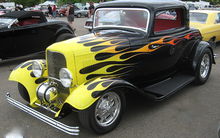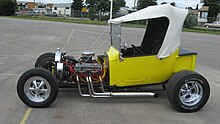




A custom car is a phrase that became prominent in American pop culture in the 1950s, and has enjoyed special interest popularity since that time. It relates to a passenger vehicle that has been modified in either of the following two ways. First, a custom car may be altered to improve its performance, often by altering or replacing the engine and transmission. Second, a custom car may be a personal "styling" statement by the re-styler/re-builder, making the car look "unique" and unlike any car that might have been factory finished.
History edit
With the change in automobile design to encase the wheels in fenders and to extend the hood to the full width of the car, the former practices were no longer possible. In addition, there was tremendous automotive advertising and subsequent public interest in the new models in the 1950s. Hence custom cars came into existence, swapping headlamp rings, grilles, bumpers, chrome side strips, and tail lights, as well as "frenching" and "tunnelling" head- and taillights. The bodies of the cars were changed by cutting through the sheet metal, removing bits to make the car lower, welding it back together, and adding a lot of lead to make the resulting form smooth (hence the term "lead sled"; lead has been replaced by Bondo). By this means, "chopping" made the roof lower;[3] "sectioning"[4] made the body thinner from top to bottom. "Channeling"[5] was cutting notches in the floorpan where the body touches the frame to lower the whole body. Fins were often added from other cars, or made up from sheet steel. In the custom car culture, someone who merely changed the appearance without improving the performance substantially was looked down on.
Paint was an important concern. Once bodywork was done, the cars were painted unusual colors. Transparent but wildly-colored candy-apple paint, applied atop a metallic undercoat, and metalflake paint, with aluminum glitter within candy-apple paint, appeared in the 1960s. These took many coats to produce a brilliant effect — which in hot climates had a tendency to flake off. Customizers also continued the habit of adding decorative paint after the main coat was finished, of flames extending rearward from the front wheels, scallops, and hand-painted pinstripes of a contrasting color. The base color, most often a single coat, would be expected to be of a simpler paint. Flame jobs later spread to the hood, encompassing the entire front end, and have progressed from traditional reds and yellows to blues and greens and body-color "ghost" flames.
Recently, as the supply of usable antique steel bodies has dried up, companies such Westcott's,[6] Harwood, Gibbon Fiberglass[7] and Speedway Motors[8] have begun to fabricate new steel and fiberglass copies.[9] Bodies of this type can cost over $100,000 before the running gear is added.[citation needed] California's "junker" (or "crusher") law, which pays a nominal sum to take "gross polluters" off the road, has been criticized by enthusiasts (and by SEMA) for accelerating this trend.[10]
Customizers edit
Examples of notable customizers include Bill Cushenbery, the Alexander Brothers, Darryl Starbird, Roy Brizio, Ron Clark[disambiguation needed] and Bob Kaiser (of Clarkaiser Customs),[11] Joe Bailon (inventor of candy apple paint),[12] "Magoo",[13] Chip Foose,[14] and Pete Chapouris. Several customizers have become famous beyond the automobile community, including George Barris and Boyd Coddington, thanks to their proximity to Hollywood; Barris designed TV's Batmobile, while Chapouris built the flamed '34 five-window coupé in the eponymous telefilm "The California Kid". Another Barris creation, Ala Kart (a '29 Ford Model A roadster pickup), made numerous appearances in film (usually in the background of diner scenes and such), after taking two AMBR wins in a row.
Notable customs edit
The most coveted award for customizers is the AMBR (America's Most Beautiful Roadster) trophy, presented annually at the Oakland Roadster Show since 1948. This competition has produced famous, and radical, customs, notably Silhouette and Ed Roth's Mysterion, some of which were turned into Hot Wheels cars, among them The Red Baron.
Others became notable for their appearances in film (such as Ala Kart, The California Kid five-window, or the yellow deuce from "American Graffiti") or television (such as The Monkeemobile, the "Munsters" hearse, or, more recently, Boyd's full-custom "Tool Time" '34, or Pete and Jake's '33 three-window, Eliminator, built for the ZZ Top video[15]). Specialist vehicles, such as the T/A, KITT, from "Knight Rider", are not usually considered customs, but movie or TV cars, because they retain a mostly stock exterior and because they are built specifically for that purpose.
Language edit
Certain linguistic conventions are followed among rodders and customizers. The model year is rarely given in full,[16] except when it might be confused, so a 1934 model, for instance, is a '34, while a 2005 might be an '05 or not. A '32 is usually a Deuce and most often a roadster, unless coupé is specified. A 3- or 5-window is usually a Ford, unless specified. A '55/6/7 is always a Chevy, unless specified. A flattie is a flathead V8[17] (always Ford, unless specified). A hemi is always a 426, unless specified;[18] a 426 is a hemi, unless Wedge is specified. A 392 is an early hemi.
- 3 deuces — arrangement of three 2-barrel (twin-choke) carburetors; distinct from Six Pak and Pontiac and Olds[19] Tri-Power[20] (also 3x2 arrangements)
- 3-window — 2-door coupé; so named for one door window on each side & one rear window[21]
- 5-window — 2-door coupé; so named for two side windows on each side & one rear window[22]
- 97s — Stromberg carburetors[23]
- A-bone — Model A coupe[24]
- Appletons (sometimes Appleton spots) — spotlights, mounted in the cowl, similar to those used by police cars
- Cammer — 427 Ford V8[25]
- Cherry — like new[26]
- Dagmars — large front bumper "bullets" (after the actress)[27]
- Decked — trunklid trim removed[28]
- Deuce — '32 Ford (most often a roadster);[29] now commonly on A frame rails[30]
- Fat-fender — 1934-48 (U.S.) car[31]
- Flatty — flathead engine[32]
- Frenched — headlight slightly sunken into fender[33]
- Gennie — genuine[34]
- Hairpins —radius rods[35]
- Hiboy (or highboy) — fenderless, but not lowered[36]
- Loboy (or low boy, lowboy) — fenderless and lowered[37]
- Mag — magnesium wheel, or steel or aluminum copy resembling one such
- Nerf bars — bumper horns[38]
- New Old Stock (NOS) — original-manufactured part, kept in storage at supplier
- Nosed — hood trim removed[39]
- QJ — Quadrajet (Rochester 4-barrel carburetor)
- Q-jet — Quadrajet
- Repop — reproduction (not NOS)[40]
- Resto — restoration, or restored
- Steelies — stock steel rims[41]
- Suicided — changed from front-hinged to rear-hinged ("suicide" door) type
- Toploader — Ford 4-speed manual transmission[42]
- Track T — Model T roadster built in the style of a dirt track race car[43]
- Tuck-and-roll — upholstery technique[44]
- Tunneled — deeply sunken into fender[45]
- Wide whites — wide-stripe whitewall tires,[46] typical of the '50s, as opposed to modern ones
- Zoomie pipes — short exhaust pipes with no mufflers, used for racing, or just for show (not street legal)
References edit
- ^ Fortier, Rob. "25th Salt Lake City Autorama", in Street Rodder, 8/99, p.51cap.
- ^ Moyer, Wayne. "T-Bucket Cruiser" in Car Modeler, 3/95, p.42.
- ^ Rod Action, 2/78, p.64.
- ^ Street Rodder, 2/78, p.15; Custom Rodder 1/97, p.29.
- ^ Jezek, George. "The All Deuce Round-Up", in Street Rodder, 2/78, p.58.
- ^ Street Rodder, 2/78, p.44.
- ^ Street Rodder, 2/78, p.43.
- ^ Street Rodder, 2/78, p.43.
- ^ See, for instance, Street Rodder, 8/99, p.183.
- ^ See, for instance, Dick Wells column "SRMA Update", Street Rodder, 8/99, p.234.
- ^ Fetherston, David, "Detroit Dreams", in Rod & Custom, 7/95, p.58.
- ^ Ganahl, Pat, "The Candy Man", in Rod & Custom, 7/95, p.81.
- ^ Street Rodder, 12/98, p.206.
- ^ Bishop, Mike, "The 45th Grand National Roadster Show", in American Rodder, 6/94, p.27.
- ^ "The ZZ Top Eliminator: Profile of a Hot Rod." by the Auto Editors of Consumer Guide, 20 September 2007, HowStuffWorks.com. Retrieved on: 28 July 2008.
- ^ For instance, Street Rodder, 8/99, passim; Rod Action, 2/78, passim;.
- ^ American Rodder, 6/94, pp.45 & 93.
- ^ Geisert, Eric. "Tom's Fun Run", in Street Rodder, 8/99, p.149cap.
- ^ Street Rod Builder, 7/03, p126.
- ^ PHR, 7/06, p.22-3.
- ^ Fortier, p.53cap.
- ^ Fortier, p.54cap.
- ^ Fetherston, David, "Track Terror", in Rod & Custom, 7/95, p.35; Emmons, Don, "Long-term Hybrid", in Rod & Custom, 7/95, p.52; & Baskerville, Gray, "Tom Brown's '60s Sweetheart", in Rod & Custom, 9/00, p.162.
- ^ Bianco, Johnny, "Leadfest" in Rod & Custom, 9/00, p.86.
- ^ Scale Auto, 6/06, p.15 sidebar.
- ^ Ganahl, Pat, "Swap 'til you Drop", in Rod & Custom, 7/95, pp.68 & 70.
- ^ Custom Rodder 1/97, p.17.
- ^ Street Rodder, 12/98, p.212.
- ^ Geisert, Eric. "The California Spyder", in Street Rodder, 8/99, p.34; Mayall, Joe. "Driving Impression: Reproduction Deuce Hiboy", in Rod Action, 2/78, p.26; letters, Rod & Custom, 7/95, p.10.
- ^ Fortier, Rob. ""A Little Pinch Here, A Little Tuck There", in Street Rodder, 8/99, p.136.
- ^ Burhnam, Bill. "In Bill's Eye", Custom Rodder 1/97, p.17; reprinted from Goodguys Gazette.
- ^ "Mr. 32", in Street Rodder, 2/78, p.40.
- ^ Fortier, p.51cap; Bianco, p.82.
- ^ Ganahl, p.70 & "Coupla Cool Coupes", p.74.
- ^ Mayall, Joe. "Joe Mayall's Driving Impression: Reproduction Deuce Hiboy", in Rod Action, 2/78, p.28 & 29.
- ^ "Street Corner", in Street Rodder, 8/99, p.16, & Fortier, "Jr.'s Highboy", p.98.
- ^ Contrast "Street Corner", in Street Rodder, 8/99, p.16.
- ^ Coonan, Steve. "Who's Chicken", in Street Rodder, 2/78, pp.56-7; 1001 Rod & Custom Ideas, 1/76, pp.24 & 25.
- ^ Bianco, p.82.
- ^ Ganahl, Pat, "Coupla Cool Coupes", in Rod & Custom, 7/95, p.74cap.
- ^ Rod & Custom, 7/95, p.143cap.
- ^ Street Rodder, 12/98, p.292.
- ^ Rod & Custom, 7/95, pp.26-7 & 33.
- ^ Tann, Jeff, "Two-Timer" in Rod & Custom, 9/00, p.58.
- ^ Street Rodder, 12/98, p.212.
- ^ Fortier, Rob. "25th Salt Lake City Autorama", in Street Rodder, 8/99, p.51cap;'Rod & Custom, 7/95, p.143cap.
Gallery edit
-
'53-6 F100 with fork flame job, an idea dating to around 1978.[1]
-
Ghost flames, a contemprary concept
-
Deuce with dropped axle, disc brakes, coilovers. Note the contrast with the much more stock Deuce on A rails. Headlight height would not be legal in some jurisdictions.[2]
-
'47 Chevy pickup with non-stock C-pillar window
-
'47 Fargo pickup with custom third door
-
Latecomer, but ubiquitious, almost anything works on the Type 1
-
3 deuces closeup
-
'32 Bantam roadster with faux mags (not "gennie" Halibrands), colormatched plugwires and distributor cap, disk brakes, hairpins,[3] headers and sidemount pipes, chrome valve covers, and mirror firewall. Also has custom interior.